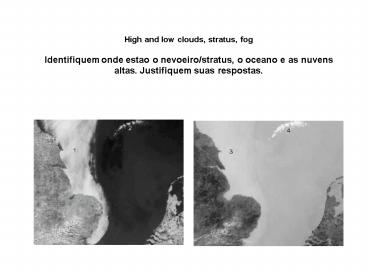High and low clouds, stratus, fog - PowerPoint PPT Presentation
Title:
High and low clouds, stratus, fog
Description:
Identifiquem onde estao as nuvens altas, o continente e o oceano e justifiquem ... In bottom of the image, the Pyrenees (3) are also brighter than the plain ... – PowerPoint PPT presentation
Number of Views:64
Avg rating:3.0/5.0
Title: High and low clouds, stratus, fog
1
High and low clouds, stratus, fog Identifiquem
onde estao o nevoeiro/stratus, o oceano e as
nuvens altas. Justifiquem suas respostas.
2
Cirrus, land - sea contrastsIdentifiquem onde
estao as nuvens altas, o continente e o oceano e
justifiquem suas respostas
3
Wave clouds, thunderstorm Nestas imagens
aparecem tempestades, nuvens que surgiram devido
a ondas de gravidade e sombras. Identifiquem
essas caracteristicas nas imagens e justifiquem
suas respostas.
Fluxo de vento causado por um ciclone na regiao
do Mediterraneo
4
High clouds, sea, mountains, forests June 20,
1998 1359 UTCSouth-west of France by a heat day
of June. On the infra-red image, the hot ground
(1) appears very dark whereas the sea (2),
colder, is brighter. In bottom of the image, the
Pyrenees (3) are also brighter than the plain
because the ground is less hot. On the visible
image, the sea (4) is darker than the land (5),
because it absorbs more the solar radiation. In
the same way, the Landes forest (6) appears
darker than the surrounding areas. Clouds over
the sea (7) are white on the infra-red image.
That means they are cold, and thus they are high
clouds. On the visible image, these clouds are
not easy to see they are thin clouds. They are
probably cirrus.
5
Cold fronts, showers, land - sea contrasts June
5, 1999 0815 UTCA cold front (1) has just passed
over the North-West of France. Behind, the sky is
almost clear. The shade of the cloudy strip
appears on the visible image. A secondary cold
front (2) approaches Brittany. Thermal contrast
is more significant there are many shower clouds
(3) behind this secondary front. The sea (4) does
not differ from the land (5) on the infra-red
image their respective temperatures should be
nearly the same. On the other hand, on the
visible image, the sea (4) is much darker than
the land (5), because it does not reflect the
solar radiation as the land does.
6
Eruption of Etna, Sicily July 28, 2001 0506
UTCSicily. The plume of smoke (1) from the
eruption of Etna is pushed by a northwest wind.
On the visible image, the shade of the plume
covers the volcano. On the infrared image, a
black zone, thus a warm one, is visible in the
volcano crater area. Lipari islands (2) are also
visible in the north of Sicily.

